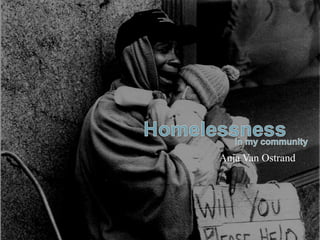
Homelessness in Skokie
- 2. Definition In my communities Root causes Analysis What I can do?
- 3. My definition: No matter what the situation, it is one of the Condition where most visible forms of people live in poverty and it shelters designed exists everywhere in for the homeless or the world! any unconventional living situation or places unintended for dwellings. Defining "homelessness" is Often countries do a complex and difficult not allow their adult thing to do. (click to see homeless population UN, ETHOS, and HUD to vote. definitions)
- 4. Why does this issue persists? How can we cure this matter that continues to affect hundreds of thousands of people?
- 5. I’ll phone Skokie’s Human Services Division responsible for housing resources on Monday to learn more! located 16 miles from Chicago (residents’ feedback) “provides high-quality government services to the over 64,000 residents” and “the opportunity to join together in building a stronger more caring community.” Skokie website celebrates multi-culturalism Ask about official (Festival of Cultures… what about those housing programs, stats about homeless, marginalized immigrants lacking a social network?) non-existence of unofficially, 3 homeless persons shelters, clean-up of McCormick bridges, no homeless shelter etc. (the most appalling story – students raise funds for substitute teacher whose wages are not enough for shelter then withdraw help… why?)
- 6. For a variety of reasons; primarily an economic problem; affected by social and political factors… (click to read more) includes people from all walks of life more than 3.5 million people each year 35% are families with children (the fastest growing segment) 25% are under 23% are U.S. military 18 years old homelessness exploded veterans in the 80s when federal “Nickel and Dimed” provides funds were withdrawn a self-study on the experience from low-income of the working poor housing and social assistance programs for low-income families 30% experienced domestic violence and the mentally ill (currently less than 50% 20-25% suffer from mental illness of 1976 spending levels)
- 7. Watch this „Gibt es echte Obdachlosigkeit in Deutschland?“ (= Are there really any homeless in Germany?) Yes! Although Germany has a strong social safety read about the net, approx. 248,000 are homeless vicious cycle (incl. homeless immigrants every 2nd homeless European lives in Germany) officially they do not exist. their # isn’t registered in governmental stats independent institutions offering social services e.g. BAG provide estimates
- 8. difficult to determine how many homeless people there are in the world countries have different legal definitions Complicated by natural disasters, civil unrest U.N. estimates 100 million (Not including those who lived in semi-permanent places e.g. abandoned buildings, tents, vehicles, hastily put together shelters, or the “hidden homeless” who bounce from shelter to shelter or from friend’s house to friend’s house) (Click to read more) (World Habitat Day)
- 9. Click to read more lack of affordable inadequate education housing, health divorce care, and safe child care drugs high cost of living, low-wage jobs, and high unemployment rates force people to choose between food, housing, and other expenses structurally perpetuated
- 10. the public has many different ways to view homelessness and how it affects individuals, economies, societies fact: it’s a worldwide problem Sociologists look at it in different ways
- 11. a concept of classification of people into groups based on shared socio-economic conditions a relational set of inequalities with economic, social, political and ideological dimensions differences lead to greater status, power or privilege for some groups over the other a system by which society ranks categories of people in a hierarchy Click to read more based on four basic principles: a) trait of society, not simply a reflection of individual differences; b) carries over from generation to generation; c) universal but variable; d) involves inequality and beliefs
- 12. social stratification exists in most societies a hierarchy is beneficial in stabilizing their existence Talcott Parsons: stability and social order are achieved by means of a universal value consensus functionalists indicate that stratification exists solely to satisfy the functional prerequisites necessary for a functional proficiency in any society
- 13. inaccessibility of resources and lack of social mobility Karl Marx: distinguished social classes by their connection to the means of production; stratification means that working class people are not likely to advance socioeconomically, while the wealthy may continue to exploit the proletariat generation after generation; the bourgeoisie/ruling class and proletarians/working class maintain their social positions by maintaining their relationship with the means of production; maintenance of system is achieved by methods of social control e.g. ideologies Max Weber: social stratification is not based purely upon economic inequalities, but also equally on status and power differentials; presence of four social classes: the propertied upper class, the property-less white-collar workers, the petty bourgeoisie, and the working class
- 14. Max Weber’s theory of social action Emil Durkheim’s collective consciousness the homeless population is ostracized from higher socio-economic groups because of actual exchanges that occur between them and those in other economic classes Example: discouraging, offending, stigmatizing, or stereotyping a homeless person as substance abuser and employers’ reluctance to hire individuals who do not possess a physical address. It dissuades some homeless people from seeking out employment.
- 15. There are countless ways to help the homeless, both directly and indirectly without spending any money. 1. Understand who the homeless are Watch a clip about 2. Respond with kindness poverty in Chicago 3. Respect the homeless as individuals 4. Bring food 5. Give recyclables 6. Donate clothing and toys 7.Volunteer at a shelter, battered women’s shelter, or your professional services 8.Tutor and mentor homeless children 9. Play with children in a shelter 9.Teach about the homeless 10. Educate your children about the homeless
